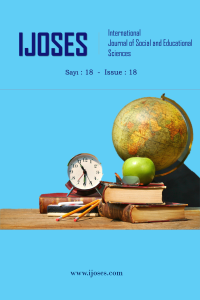Research Article
Year 2022,
Issue: 18, 59 - 68, 15.12.2022
Abstract
İslam toplumuna dâhil olan farklı dinî ve felsefî akımların Hz. Peygamberin nübüvvetine yaptıkları itirazları bertaraf edebilmek için Müslüman âlimlerce geliştirilen savunmacı refleks, tarihi süreçte delâilü’n-nübüvve isimli geleneğin oluşmasına zemin hazırlamıştır. İlkin Muʽtezilî âlimlerin çabalarıyla vücud bulmaya başlayan bu gelenek, daha sonra selefi düşünürler ile hadis âlimlerinin çalışmalarıyla daha da genişleyerek varlığını devam ettirmiştir. Bu gelişmeler nübüvvetin ispatında farklı metodların zuhur etmesini de doğal hale getirmiştir. Nitekim Mu’tezile’nin geliştirdiği akıl ve nakil merkezli tavrın yanı sıra sadece nakli merkeze alan bir rivayetçi yaklaşımın da ortaya çıktığı görülmektedir. Bu bağlamda Mu’tezilî kimliğiyle bilinen Kadı Abdülcabar’ın “Tesbitü Delâilü’n-Nübüvve” isimli eseri ile muhaddis kimliğiyle ön plana çıkmış Beyhâkî’nin “Delâilü’n-Nübüvve” isimli eseri, hicri beşinci asırda Muhammed'in nübüvvetini ispat etmek üzere iki farklı metod kullanılarak telif edilen eserlerdendir. Biz bu çalışmamızda hicri V. asırda metodik farklılıkları bulunan iki delail müellifi ile eserini tanıtmayı ve mukayese etmeyi planlamaktayız. Ayrıca müelliflerin hayatları hakkında bilgiler vermek suretiyle de bu iki müellifin yaşadığı süreç ve fikri ortam üzerinden metod farklılıklarının daha anlaşılır hale geleceğini de düşünmekteyiz.
References
- Beyhâkî, Ebû Bekr Ahmed b. el-Hüseyn b. Ali (2017), Delâilü’n-Nübüvve, terc. Hüseyin yıldız v. dğr., İstanbul: Ocak Yay.
- İbn Hallikan, Ebû’l-Abbâs Şemsüddîn Ahmed b. Muhammed (1978), Vefayâtü’l-A’yân, thk. Dr. İhsan Abbas, Beyrut: Daru’s-Sadr.
- İbn Murtaza, Ahmed b. Hüseyin (1987), Tabakatü’l-Mu’tezile, thk. S. Diwald-Wilzer, Beyrut: y.y.
- İbn Nedim, Muhammed b. İshak (2017), el-Fihrist, çev. Mehmet Yolcu vd., İstanbul: Çıra Yay.
- Kadı Abdülcabbar (2012), el-Mugni fî ebvabi’t-Tevhid ve’l-Adl, Beyrut: Daru’l-Kütübi’l-İlmiyye.
- Kadı Abdülcabbar (2017), Tesbitü Delâilü’n-nübüvve, çev. M.Şerif Eroğlu-Ömer Aydın, İstanbul: Türkiye Yazma Eserler Kurumu Başkanlığı Yayınları.
- Kandemir, M. Y.(1992), Beyhâkî, TDV İslâm Ansiklopedisi, (c. VI, ss. 61-62), İstanbul: TDV. Yay.
- Kırış, Ş.(2015), Beyhâkî’nin Delâilü’n-Nübüvve Adlı Eserinin Kaynakları, Usûl: İslam Araştırmaları, S. 23, ss. 95-126.
- Topaloğlu, B. (2011), Tesbitü Delâilü’n-Nübüvve, TDV İslâm Ansiklopedisi, (c. XXXX, ss. 535-536), İstanbul: TDV. Yay.
- Topaloğlu, N. (1983), Beyhâkî Hayatı, Eserleri ve Şahsiyeti, Dokuz Eylül Üniversitesi İlahiyat Fakültesi Dergisi. S. 1, ss. 333-338.
- Yavuz, Y.Ş.(1992), Beyhâkî, TDV İslâm Ansiklopedisi, (c. VI, ss. 58-61), İstanbul: TDV. Yay.
- Yavuz, Y.Ş.(1994), Delâilü’n-Nübüvve, TDV İslâm Ansiklopedisi, (c. IX, ss. 115-117), İstanbul: TDV. Yay.
- Yurdagür, M. (1986), Son Dönem Mu‘tezilesinin En Meşhur Kelâmcısı Kâdî Abdülcebbâr Hayatı ve Eserleri, Marmara Üniversitesi İlahiyat Fakültesi Dergisi, c. 4, ss. 117-136.
- Yurdagür, M. (2001), Kādî Abdülcebbâr, TDV İslâm Ansiklopedisi, (c. XXIV, ss. 103-105), İstanbul: TDV. Yay.
A tradition of Delâilül'n-Nubuvva in the 5th Hijri Century: The Sample of Qadi Abd-al-Jabbar and Bayhāqī
Abstract
The defensive reflex developed by Muslim scholars in order to eliminate the protest to the prophethood of Muhammad paved the way for the formation of the tradition that ıt’s called dalāılu'n-nubuvva in the historical process that the different religious and philosophical movements get involved in the Islamic society. This tradition which first started to come into existence with the efforts of Muʽtazilī scholars developed and continued its existence by the work of Salafist thinkers and hadith scholars. These developments made it possible for different methods naturally to emerge in the proof of prophecy. As a matter of fact that in addition to the wisdom and transmission-centered attitude developed by the Muʽtazila section has emerged a approach of narrator that only focuses on the transmission-centered. In this context, the work of Kadı Abd al-Jabbar who is known as Muʽtazilī scholar that its name "Tesbitu Dalāilu'n-Nubuvva" and the work of Bayhāqī who is muhaddith scholar that is name "Dalāilu'n-Nubuvva" was designed to prove the prophethood of Muhammad in the fifth century of the hijra by copyrighted using two different methods. In this study, we are planning to introduce and compare with outlines the two works of delâil authors who had methodical differences in the 5th century hijri. In addition, we think that by giving information about the lives of the authors, the method differences will become more understandable through the process and intellectual environment of these two authors.
References
- Beyhâkî, Ebû Bekr Ahmed b. el-Hüseyn b. Ali (2017), Delâilü’n-Nübüvve, terc. Hüseyin yıldız v. dğr., İstanbul: Ocak Yay.
- İbn Hallikan, Ebû’l-Abbâs Şemsüddîn Ahmed b. Muhammed (1978), Vefayâtü’l-A’yân, thk. Dr. İhsan Abbas, Beyrut: Daru’s-Sadr.
- İbn Murtaza, Ahmed b. Hüseyin (1987), Tabakatü’l-Mu’tezile, thk. S. Diwald-Wilzer, Beyrut: y.y.
- İbn Nedim, Muhammed b. İshak (2017), el-Fihrist, çev. Mehmet Yolcu vd., İstanbul: Çıra Yay.
- Kadı Abdülcabbar (2012), el-Mugni fî ebvabi’t-Tevhid ve’l-Adl, Beyrut: Daru’l-Kütübi’l-İlmiyye.
- Kadı Abdülcabbar (2017), Tesbitü Delâilü’n-nübüvve, çev. M.Şerif Eroğlu-Ömer Aydın, İstanbul: Türkiye Yazma Eserler Kurumu Başkanlığı Yayınları.
- Kandemir, M. Y.(1992), Beyhâkî, TDV İslâm Ansiklopedisi, (c. VI, ss. 61-62), İstanbul: TDV. Yay.
- Kırış, Ş.(2015), Beyhâkî’nin Delâilü’n-Nübüvve Adlı Eserinin Kaynakları, Usûl: İslam Araştırmaları, S. 23, ss. 95-126.
- Topaloğlu, B. (2011), Tesbitü Delâilü’n-Nübüvve, TDV İslâm Ansiklopedisi, (c. XXXX, ss. 535-536), İstanbul: TDV. Yay.
- Topaloğlu, N. (1983), Beyhâkî Hayatı, Eserleri ve Şahsiyeti, Dokuz Eylül Üniversitesi İlahiyat Fakültesi Dergisi. S. 1, ss. 333-338.
- Yavuz, Y.Ş.(1992), Beyhâkî, TDV İslâm Ansiklopedisi, (c. VI, ss. 58-61), İstanbul: TDV. Yay.
- Yavuz, Y.Ş.(1994), Delâilü’n-Nübüvve, TDV İslâm Ansiklopedisi, (c. IX, ss. 115-117), İstanbul: TDV. Yay.
- Yurdagür, M. (1986), Son Dönem Mu‘tezilesinin En Meşhur Kelâmcısı Kâdî Abdülcebbâr Hayatı ve Eserleri, Marmara Üniversitesi İlahiyat Fakültesi Dergisi, c. 4, ss. 117-136.
- Yurdagür, M. (2001), Kādî Abdülcebbâr, TDV İslâm Ansiklopedisi, (c. XXIV, ss. 103-105), İstanbul: TDV. Yay.
There are 14 citations in total.
Details
| Primary Language | Turkish |
|---|---|
| Journal Section | Research Articles |
| Authors | |
| Publication Date | December 15, 2022 |
| Submission Date | September 20, 2022 |
| Acceptance Date | October 28, 2022 |
| Published in Issue | Year 2022 Issue: 18 |
Indexes
Indexes
INDEX COPERNİCUS [ICI], Eurasian Scientific Journal Index [ESJI], ISAM [Makaleler Veri Tabanı], SOBIAD, Scilit, İdeal Online
tarafından dizinlenmekte.
TÜBİTAK/ULAKBİM(TR) SBVT tarafından izlenmektedir.


